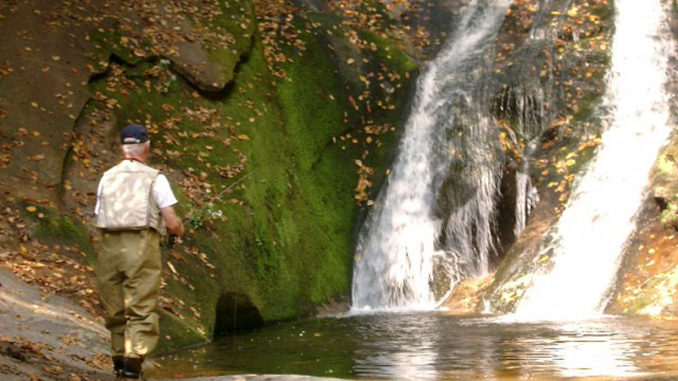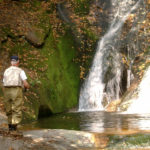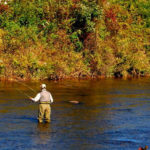
Streams are empty of anglers, full of hungry trout
November can be a tough time for fly-fishing with all the new leaf fall in the streams. Consider snagged leaves on retrieves as a normal, if not annoying, part of the normal fishing day. Plus, November’s weather can be erratic — warm and sunny one day, cold and rainy the next.
Minor disadvantages aside, November is an ideal month for trout fishing. Trout become accustomed to leaves and pine needles falling into the water, so they’re less spooky than usual. Fair-weather fishers have called it quits for the season, so there are fewer on the streams Water temperatures have moderated, so trout are more active than usual. Brown trout are ending their spawning runs, so the chances of catching a lunker brown are good.
Walker Parrott, fly-fishing masters champion and full-time guide for Davidson River Outfitters in Brevard (828 877-4181), said November is as good as October for trout fishing.
“You’ll find bigger fish and less pressure,” he said, “and the fish are easier to catch.”
Parrott downsizes his gear for late fall and early winter, using a 6X fluorocarbon tippet and small flies, usually Nos. 18 to 16.
“Delayed-harvest streams are very productive in November,” he said, explaining that streams were heavily stocked for the beginning of the catch-and-release season on Oct. 1, and trout have become acclimated to their new habitat, behaving much like wild trout, only hungrier.
Matt Canter, a full-time guide at Brookings Outfitters in Cashiers (828 743-3768), said water levels and temperatures usually are ideal, and trout are more aggressive and less picky. Canter uses a 9 ½-foot tapered leader with a 6X tippet for dry-fly fishing and a 4X or 5X tippet for nymph fishing. Preferred colors for flies are brown and black. Canter likes big nymphs and streamers this month. his nymph preferences run No. 14 and larger.
To target big, post-spawn browns, Canter says egg patterns are especially effective because brown trout eat the eggs and young of other trout. Egg patterns should match the size and color of the spawned eggs, No. 14 or smaller. Pink or foam Glo eggs work best. Dead-drifting egg patterns gets the most strikes. Canter’s leader and tippet preferences are a 9 ½-foot tapered leader with a 6X tippet for dry-fly fishing and a 4X or 5X tippet for nymph fishing.
When spawning, brown trout seldom eat, so when they return to their normal habitat, they’ll gobble up most anything available. For lunker browns, Canter suggests fishing large, deep pools with big streamers such as Nos. 2 or 4 Sculpzilla, an altered Sculpin pattern. For this type of fishing, a sinking-tip line is recommended.
“The streamer should get down deep and have a lot of articulation,” he said.
The disadvantage of using large streamers is you’ll spend an inordinate amount of time casting without a strike, but when you do get a strike, it will be a pole-bender.
Steve Claxton of Bryson City (828 736-7501) guides mainly on Great Smoky Mountains National Park streams, particularly Hazel Creek. He said fishing success often depends on water temperatures, with the ideal range being the mid- to upper-50s. He uses a 12-foot leader with a 5X tippet. His preferred flies are a No. 14 orange parachute Adams, a No. 16 Thunderhead and No. 14 orange Palmer or Stimulator.
Brook trout also spawn in the fall, a bit later than browns. Prime spawning time for brookies is mid-October through mid-November. Since wild brook trout usually are found in small streams, they don’t move as much or as far as browns.
Recommended dry flies for November are Blue-Winged Olives in Nos. 20 to 18, —Tricos in Nos. 20 to 18 and the always-effective gray midge in Nos. 20 to 18. Good attractor patterns are Nos. 14 to 12 Royal Wulff, Nos. 14 to 12 parachute Adams, Nos. 14 to 12 male Adams and Nos. 14 to 12 Thunderhead. For nymph fishing, No. 10 My Pet, Nos. 12 to 10 Zug Bug, Nos. 12 to 10 Hare’s Ear, No. 10 rubber-legged Girdlebug and Nos. 12 to 10 Prince. A No. 10 or larger brown, black, chartreuse or olive Woolly Booger is a good fly for targeting large browns and large rainbow trout.







Be the first to comment